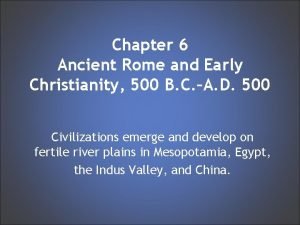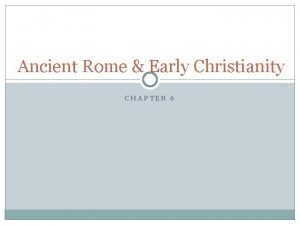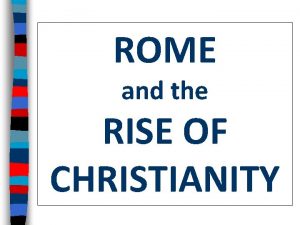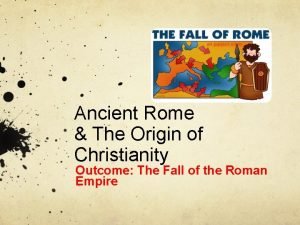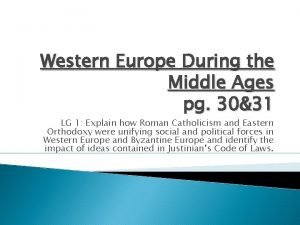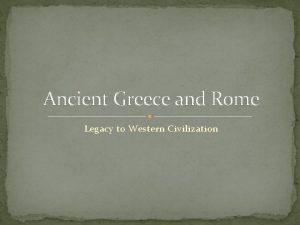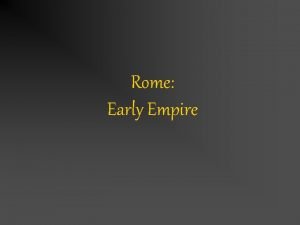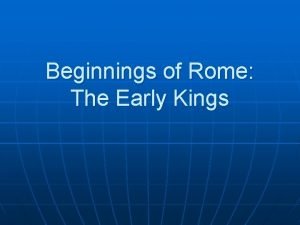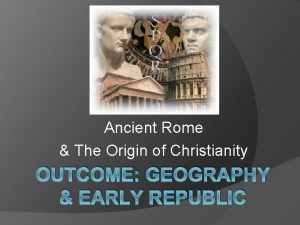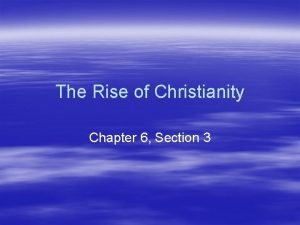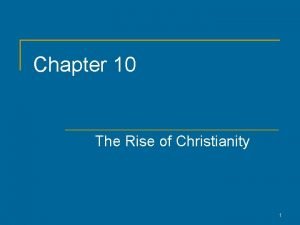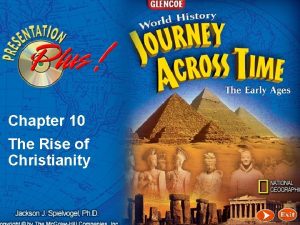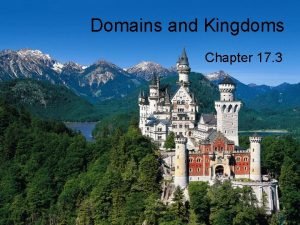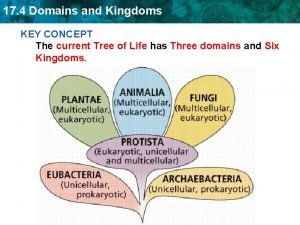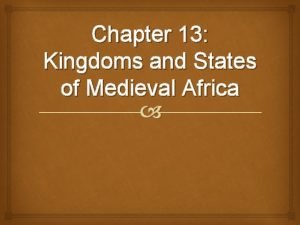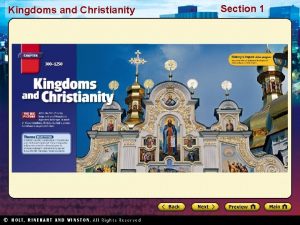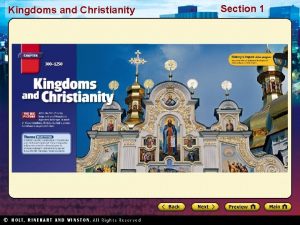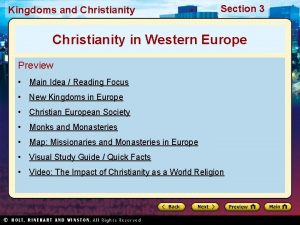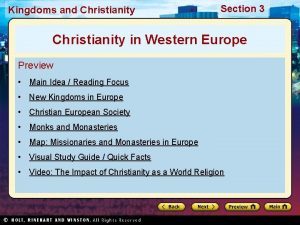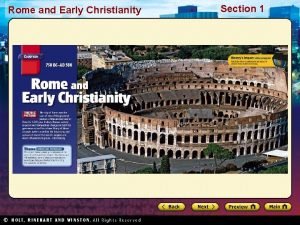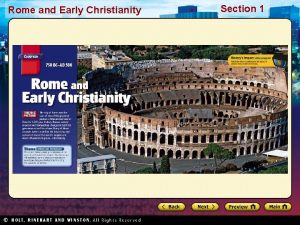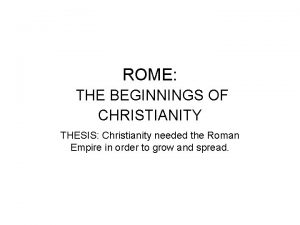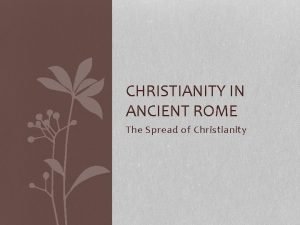CHAPTER 12 Kingdoms of early Christianity Western Rome

















- Slides: 17

CHAPTER 12 Kingdoms of early Christianity

Western Rome fell in 476 CE

The Byzantine Empire After the fall of Western Rome (476) Emperor Constantinople I moved the capital of the Eastern Roman Empire to Constantinople Eastern Roman Empire: Larger and richer than Rome Sea protected it from two sides

Nika Revolt Justinian I dreamed of restoring the original Roman Empire � Military action was needed � Took back Northern Africa through conquest People resented Justinian’s efforts for reform Revolted in 532: “Nika Revolt” � “Greens” lower class � “Blues” upper class Justinian & Theodora put down revolt

Achievements Nika revolt destroyed parts of Constantinople � Justinian had chance to rebuild � Hagia Sophia “Holy Wisdom” Reformed Roman Law � Organized existing laws into a clear system � “Justinian's Code”

Byzantine Culture: Emperor & Christianity Emperor � Priest-king considered deputy of Jesus Christ � Emperor Heraclius made the official language Greek Christianity � Dominated Byzantine art � : pictures created with tiny tiles � Most subjects of saints and figures from the Bible

Iconoclasts In the 700 s, controversy erupted over the use of : paintings/sculptures of sacred figures � Some objected to their use; believed to be idol worship � Emperor Leo II forbid the use of icons, � : icon breakers

Church Splits Over time the issues that divided the eastern and western churches grew � The use of Greek � Clergy marriage 1054: final : split : “right opinion” East � Roman Catholic Church: West �

The fall of Constantinople Strife between military and government grew 1453: Ottoman Turks attacked the city � Renamed city Istanbul

The Growth of Russia In the mid 800 s the Slavs were fighting among themselves and asked for help from Northern Europeans � Perhaps Vikings � Called the “Rus” By the late 900 s the Rus had extended control to Kiev and beyond

Russian Achievements Two monks: Cyril and Methodius � Spoke the Slavonic language � Used Slavonic instead of Greek to celebrate mass � Used Greek alphabet to record their language � � Thanks to Cyrillic, Byzantine version of Christianity spread to Russia

Christian Russia Within 100 years had spread throughout Russia After the SCHISM, Russia set up a semiindependent church linked to the Orthodox church in Constantinople

Christianity in Western Europe After the Fall of Rome, no single empire arose like the Byzantine Empire in the East Instead, Germanic groups who had invaded Rome established many small kingdoms

Anglo-Saxon England Angles & Saxons had once lived in what is now Germany Migrated to Britain in 400 s Established seven small independent kingdoms � KINGDOMS Augustine of Canterbury converted many in the kingdom of Kent to Christianity spread through England

Anglo-Saxon England The Danes invaded northern England began to march south To fight back, the Anglo-Saxons united under � Alfred the Great Alfred pushed the Danes back to the north Alfred was recognized as ruler of all England � Developed a code of laws � Established a system of schools that educated adults and children

The Franks Germanic kingdom in Gaul � Modern day France Leader “Clovis” vowed to adopt Christianity if he won a battle 496, Franks became Christian

Medieval Period “Middle Ages” Lives were filled with suffering and hardship Christianity spread, and people became missionaries to help spread religion : Christian society in Western Europe � Pope Gregory the Great gave more authority to pope � Encouraged : voluntary separation from society to dedicate one’s life to God
 Ancient rome and early christianity
Ancient rome and early christianity Chapter 6 ancient rome and early christianity
Chapter 6 ancient rome and early christianity Rome and the rise of christianity
Rome and the rise of christianity Ancient rome and the origins of christianity
Ancient rome and the origins of christianity Who was the leader of the franks
Who was the leader of the franks Rome and the roots of western civilization
Rome and the roots of western civilization Rome and the roots of western civilization
Rome and the roots of western civilization Early empire rome
Early empire rome Early kings of rome
Early kings of rome Ancient rome outcomes geography and early republic
Ancient rome outcomes geography and early republic Early cpr and early defibrillation can: *
Early cpr and early defibrillation can: * Chapter 6 section 3 guided reading the rise of christianity
Chapter 6 section 3 guided reading the rise of christianity Chapter 10 the rise of christianity
Chapter 10 the rise of christianity Chapter 10 the rise of christianity
Chapter 10 the rise of christianity Chapter 17 domains and kingdoms answer key
Chapter 17 domains and kingdoms answer key Concept mapping chapter 17 domains and kingdoms
Concept mapping chapter 17 domains and kingdoms Kingdoms and states of medieval africa
Kingdoms and states of medieval africa Chapter 13 kingdoms and states of medieval africa
Chapter 13 kingdoms and states of medieval africa
